Summary
In recent years, with the economic globalization and social development, the phenomenon of returning home has become increasingly common. Some of the returnees may be at risk of anti-epidemic emergencies. For this reason, this article discusses the management plan for returnees during the epidemic from a macro level. . First, establish an information registration system for people returning from the epidemic; secondly, place returnees in isolation areas for medical observation; finally; improve the management and circulation mechanism for returnees, formulate strict testing rules; strengthen health education, and ensure local food Featured emergency warning and emergency response plans. This article discusses the necessity of management plans for returnees during the epidemic, and strives to address possible epidemic risks for returnees as soon as possible while maintaining social stability.
The main functional modules of the epidemic returnee management system studied in this project include: epidemic prevention instructions, epidemic supplies, return report, user feedback management, etc. It mainly uses Mysql as the main storage unit of background data, using software engineering principles and The development method is built using Python's Django technology and realizes all the functions of the system. This report first analyzes the background, role, and significance of the research, laying the foundation for the rationality of the research work. Analyzing the various needs and technical issues of the management system for people returning from the epidemic, proving the necessity and technical feasibility of the system, and then giving a basic introduction to the technical software and design ideas that need to be used to design the system, and finally implementing the epidemic Returning personnel manages the system and deploys operations using it.
Keywords: Django framework; Mysql database; epidemic returnees management system
Django epidemic return personnel management system
Abstract
In recent years, with the economic globalization and social development, the phenomenon of returning home has become increasingly common, and some of the returning people may have the risk of anti-epidemic emergencies. Therefore, this paper discusses the management plan of returning people during the epidemic from the macro level. First of all, establish the information registration system for people returning from the epidemic; Secondly, put the returnees into the isolation area for medical observation; last; Improve the management and circulation mechanism of returning personnel, and formulate strict detection rules; Strengthen health education and launch emergency early warning and emergency response plans with local characteristics. This paper discusses the necessity of the management plan for the returnees during the epidemic, and tries to solve the possible epidemic risks of the returnees as soon as possible while maintaining social stability.
The main functional modules of the epidemic return personnel management system studied in this project include: epidemic prevention instructions, epidemic supplies, return reporting, user feedback management, etc. It mainly adopts MySQL as the main storage unit of background data, uses software engineering principles and development methods, and uses Python's Django technology to build, and realizes all the functions of the system. This report first analyzes the background, role and significance of the research, laying a foundation for the rationality of the research work. Based on the analysis of various requirements and technical problems of the management system for epidemic returnees, the necessity and technical feasibility of the system are proved, and then the technical software and design ideas needed for the design of the system are introduced. Finally, the implementation and deployment of the management system for epidemic returnees are implemented.
Key words:Django framework; MySQL database; Management system for epidemic returning personnel
Table of contents
(1) Research background and significance
( 3 ) Organizational structure of this article
2. Introduction to development tools and related technologies
( 1) Development technical description 3
( 2) Mysql database 3
( 3) Introduction to Python 4
( 4) Django framework 4
( 5) Working principle of B/S system 4
(2) Functional requirements analysis
(3) Non-functional requirements analysis
(1) Implementation of user login
(2) Implementation of the main functions of the system front desk
In recent years, with the economic globalization and social development, the phenomenon of rural returnees has become increasingly common. Many rural returnees will work in cities for short-term jobs to increase family income. However, they may be returning from places that have been greatly affected by the epidemic. In the event of a sudden epidemic, their return may also bring potential health risks to other farmers. Therefore, to maintain the health and safety of returnees during the epidemic and prevent epidemic risks, we must establish an effective management plan for returnees. We must establish a personal information registration system for returnees and establish the trajectory of returnees from the beginning, so that adequate measures can be taken to achieve health monitoring and unified management. Among them, we need to register the travel journey, body temperature information and other health information of those returning home. This information can be used as a reference for epidemic prevention and control. It is necessary to improve the management mechanism for returnees, scientifically and rationally arrange the residences of returnees, formulate strict testing rules, and strengthen health education. At the same time, it is necessary to launch emergency warning plans based on local characteristics, timely grasp the trend of people movement in Xinjiang, take emergency response measures in a timely manner, and increase epidemic prevention and control efforts.
Therefore, a "Django epidemic returnee management system" was developed. It is hoped that the implementation of this plan can better safeguard social revitalization and rural development, and solve the epidemic risks of people returning home during the epidemic as soon as possible.
- research content
The development and implementation of the management system for people returning from the epidemic requires the following work:
(1) First, determine the topic, determine the system to be built, and conduct a preliminary systematic confirmation of the background of the system and some of the problems currently faced.
(2) After the system is confirmed, the technology used in system development is confirmed based on the needs of system development. The development of the epidemic returnees management system uses the Django framework and database to build and develop the platform. The technology used is confirmed for technical analysis. Whether the technology used can complete the implementation of the system.
(3) Determine the technology used in the system, confirm online the user roles divided by the system, and determine the functional modules to be designed based on the user role division. The design of the epidemic returnee management system is mainly divided into administrator and user roles. , and the functional modules used are also different, but the content implemented by the system's database is interactive. Users can query epidemic policies and return home reports at any time according to their own needs. For system staff, they can according to their own responsibilities The content is processed and operated online. The administrator obtains the detailed data information of all users and handles it as soon as possible according to the needs.
(4) After the functional modules of the system are confirmed, the program and interface are designed. After the design is completed, tests are conducted to determine whether the program is perfect. For system testing, different users are required to edit and submit different content, and use different The testing method finds out the loopholes in the program and solves the loopholes in the program online. If there are no problems with the test system, the system can be uploaded for formal operation.
- Organizational structure of this article
Six chapters together constitute the research and design content of this article, including:
Chapter One Introduction. The beginning of this article provides a textual description of the research background and significance of this topic.
Chapter 2: Introduction to related technologies. Mainly introduces the Django framework, Python embedded scripting language, B/S mode, etc.
Chapter 3: System analysis. Including description of the overall system requirements, analysis of system requirements from a functional perspective, non-functionality and other aspects to analyze whether the system can be implemented.
Chapter 4: System Design. The important part of this article provides the detailed design of the system architecture and the design instructions of some main functional modules.
Chapter 5: System implementation. This system is divided into prerequisite development tool introduction and later functional code implementation.
Chapter Six: System Testing. After the system is completed, each module will be functionally tested based on the test cases of each module.
(1) Development technical description:
The front-end part of this system is developed based on the MVVM model, using the B/S mode, and the back-end part is developed based on the python Django framework.
Front-end part: The front-end framework uses the popular progressive PythonScript framework Vue.js. Use Vue-Router and Vuex to realize dynamic routing and global state management, Ajax to realize front-end and back-end communication, Element UI component library to quickly prototype the page, and the project front-end to achieve responsiveness through grid layout, which can be adapted to PC, tablet, mobile phone, etc. Perfect layout display for different screen sizes.
Back-end part: Use Django as the development framework and integrate Redis and other related technologies.
(2) Mysql database
Mysql is a multi-user, multi-thread server that uses SQL database. The database management system is based on the relationship between SQL users and server modes. Its advantages include powerful functions, simple operation, convenient management, reliability and security, and fast operation. , multi-threading, cross-platform, fully networked, stable, etc., it is very suitable for the development of Web sites or other application software in the database back-end. In addition, using many languages, members can write and access MySQL database programs. Mysql database is also open source. Developers are increasingly fond of using Mysql relational database, and its application scope has also been extended. Because of its speed and ease of use, it is also used in the development of database backends for Web sites or application software.
The mysql database has many advantages, such as its easy-to-understand operation, powerful functions, and high information storage capacity. Therefore, it is widely used by people. For mysql database, it is generally mainly used for encoding and querying data, and it is applied to this database in many designs. In this process, we can query and combine conventional data, so When we use the mysql database, we only need to write a small piece of data to achieve the corresponding function. A database is a storage room for data storage, but the data is stored on a computer instead of a real storage room. The data is stored in a fixed format, not disordered. The definition is: a fixed format for a long time. Storage on computer memory that can be shared. Database management mainly includes the establishment of data tables, data storage, modification and addition of data. In order to ensure that the database system can operate normally, the management work carried out by relevant personnel. The establishment of the data table can adjust the data in the data table, recombine and reconstruct the data to ensure the security of the data.
(3) Introduction to Python
Python is a high-level scripting language that combines interpreted, compiled, interactive, and object-oriented programming. Python's design, compared to other languages that often use English keywords and some punctuation marks from other languages, has a more distinctive grammatical structure than other languages and is highly readable.
Interpreted languages: Similar to Python and Perl languages, this means that there is no compilation link in the development process.
Interactive languages: code can be executed directly after a Python prompt >>>.
Object-oriented language: Python supports object-oriented style or programming techniques in which code is encapsulated in objects
(4) Django framework
1.Spring’s advantages:
Through Spring's IOC feature, the dependencies between objects are controlled by Spring, which facilitates decoupling and simplifies development.
2. Advantages of Spring MVC:
SpringMVC is a lightweight web framework that uses MVC design ideas to decouple the web layer and make our development simpler.
3. Advantages of Mybatis:
Database operations (sql) are configured using xml files, decoupling sql and code, providing mapping tags, supporting mapping of objects and database orm field relationships, object relationship mapping tags, and xml tags for supporting the establishment of object relationships. Support dynamic sql.
2.5 Working principle of B/S system:
The B/S architecture adopts the working mode of browser request and server response.
Users can access text, data, pictures, animations, video on demand, sounds and other information generated by Web servers on the Internet through a browser;
Each Web server can be connected to the database server in various ways, and a large amount of data is actually stored in the database server;
Download the program from the Web server to the local for execution. If you encounter instructions related to the database during the download process, the Web server will hand it over to the database server for interpretation and execution, and return it to the Web server, and the Web server will return it to the user. In this structure, many networks are connected together to form a huge network, that is, the global network. Each enterprise can build its own Internet based on this structure.
In the B/S mode, the user requests access through the browser to many servers distributed on the network. The browser's request is processed by the server, and the processing results and corresponding information are returned to the browser. Other data All processing and requests are completed by the Web Server. Through this framework structure and the browser embedded inside the operating system, this structure has become the mainstream structure pattern of today's software applications. .
This system will conduct feasibility analysis from three perspectives: economic, technical and operational.
The entire system has rigorous steps from design to development and testing. All work tasks are completed by myself without external technical support, saving all service costs and labor costs. In terms of hardware, a second-hand mobile phone is used to save costs. As a project deployment server and database server, the workstation costs less than 10,000 yuan. The entire network deployment is completed by myself independently without any other labor costs. The entire development process is based on the principle of low cost and low consumption.
The purpose of the technical feasibility analysis is to confirm whether the system can be implemented using existing technology and to evaluate development efficiency and completion. Technical feasibility refers to whether the development of computer software and hardware can meet the development requirements under the current technical conditions. Because the development of this system is based on the Python language, the software and hardware conditions required to develop the system can be met on ordinary computers. Because it occupies relatively little memory, there is theoretically no problem in developing and designing software with Mysql database because it occupies too little memory. The above technologies can effectively ensure the successful and efficient development of the system.
The interface of the management system for people returning from the epidemic is simple and easy to operate. It uses a common interface window to log in to the interface and perform access operations through a computer. Users can access the system as long as they have used computers in daily life. This system is developed using Python technology. Humanization and perfection are the more prominent features of B/S structure development, making user operation simpler and more convenient than others. Easy operation, easy management, and good interactivity are fully reflected in the operation of this system.
The user use case diagram is shown below.

Figure 1 User use case diagram
The administrator use case diagram is shown below.
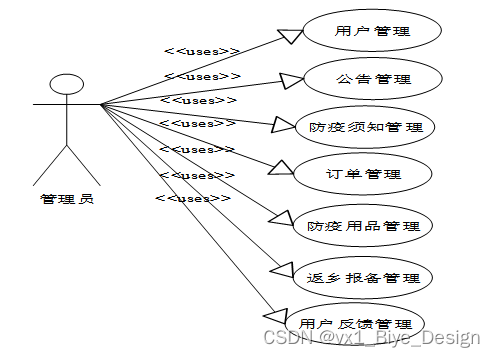
Figure 2 Administrator use case diagram
The use case description for adding epidemic prevention instructions is shown in the table below.
Table 1 Epidemic prevention instructions add use case description
| Use case name |
Add new epidemic prevention instructions |
|
| participants |
administrator |
|
| Use case overview |
This use case is used by administrators to add new epidemic prevention instructions. |
|
| Preconditions |
Administrators must log in to the system before adding new epidemic prevention instructions |
|
| postcondition |
Add a new epidemic prevention notice to the system |
|
| basic event flow |
Participant actions |
System response |
4. The administrator fills in the new epidemic prevention instructions and clicks the "Add" button. |
2. The system opens the interface for adding new epidemic prevention instructions. 3. The system checks that the epidemic prevention instructions entered by the administrator are correct and valid. 5. The system adds epidemic prevention instructions to the database. 6. The system prompts "Operation successful". 7. The system jumps to the epidemic prevention instructions management interface. |
|
| Other event streams |
If the system verifies that the name of the epidemic prevention instructions entered by the administrator is empty, it will prompt "*Please fill in the epidemic prevention instructions!". |
|
The user editing use case description is shown in the following table.
Table 2 User editing use case description
| Use case name |
Modify user |
|
| participants |
administrator |
|
| Use case overview |
This use case is used by administrators to modify user information. |
|
| Preconditions |
The administrator has logged into the system |
|
| postcondition |
Update a user record in the system |
|
| basic event flow |
Participant actions |
System response |
| 1. The administrator selects "User Management" on the main interface of the background. 4. The administrator selects a user in the user list and clicks the "Edit" button. 6. The administrator fills in the user information and clicks the "Save Changes" button. |
2. The system obtains user information from the database. 3. The system opens the user list interface. 5. The system opens the interface for modifying user information. 7. The system adds the changes to the database. 8. The system prompts "Operation successful". 9. The system jumps to the user management interface. |
|
| Other event streams |
none |
|
The use case description of epidemic supplies information is shown in the following table.
Table 3 Epidemic supplies information use case description
| Use case name |
Epidemic supplies information |
|
| participants |
user |
|
| Use case overview |
This use case is used by users to query information about epidemic supplies. |
|
| Preconditions |
The user has logged into the system |
|
| postcondition |
Query detailed information on epidemic supplies |
|
| basic event flow |
Participant actions |
System response |
| 1. The user selects any epidemic supplies information on the front page. 4. The administrator selects an epidemic supplies information in the user list. 7. The user selects epidemic supplies information and clicks the "Query" button. |
2. The system obtains the epidemic supplies information list information from the database. 3. The system opens the epidemic supplies information list interface. 5. The system obtains epidemic supplies information from the database. 6. The system opens the epidemic supplies information interface. 8. The system checks that the information entered by the user is correct and valid. |
|
| Other event streams |
1. The system verifies that the field entered by the user is empty and prompts "*Epidemic supplies information cannot be empty!". |
|
As the number of users increases, the system may need to serve thousands or tens of thousands of pages at the same time. The server needs to respond to the operations of a large number of users at the same time. This requires the system to have good scalability, otherwise the system will experience delays and lags. Even server crashes. High scalability allows the software to maintain strong vitality, and also enables the system to better adapt to changes such as increased users, improved performance requirements, and increased application functions.
A large amount of personal information of users and administrators is stored in the system. Therefore, ensuring the security of the system server and data is an important issue that needs to be considered during the development process. Security includes server security, operating system security, database security, program code security, and user personal information and payment security. The system can enhance its security by using firewall technology, encryption technology, authentication technology, etc. There is only a robust and secure system. Only then can it have long-lasting vitality.
In the front desk of the management system for people returning from the epidemic, the user module mainly implements the following functions: querying epidemic prevention instructions, purchasing epidemic supplies, reporting for return home, and conducting user feedback exchanges. In the background of the management system for people returning from the epidemic, the administrator processes the data submitted by users at the front desk to meet the needs of users. There is data interaction between the front-end system and the back-end system, and all parts of the entire system are independent and inseparable from each other. The functions of the backend mainly include user management, announcement management, epidemic prevention information management, epidemic supplies management, return home reporting management, user feedback management, communication management, etc.
The following is the top-level data flow chart of the system. System users are divided into administrators and ordinary users.

Figure 3 System data flow chart (top level)
The following figure shows the underlying data flow chart of the system, which specifically describes the functional modules used by system users.
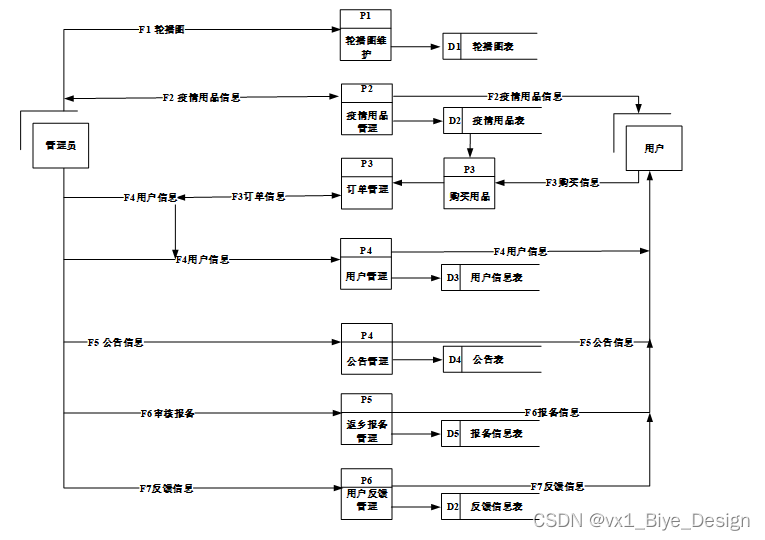
Figure 4 System data flow chart (bottom layer)
The basic functional requirements of the system have been obtained through software requirements analysis. According to the different functional modules, the system is divided into various functional blocks. The system functional structure is shown in the figure below.
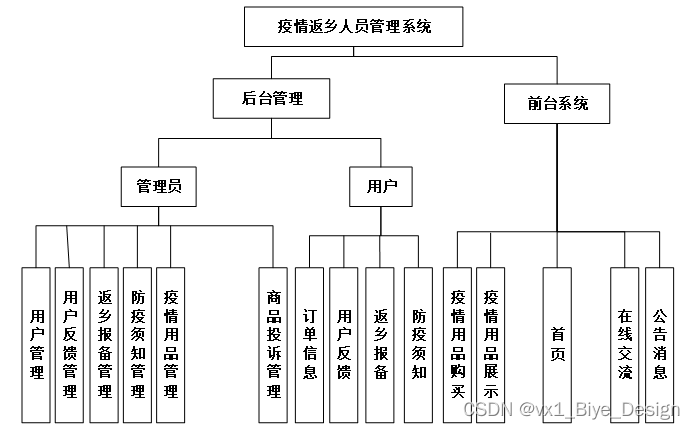
Figure 5 System functional structure diagram
The conceptual design includes two parts: entity and contact. For example, in this system, a user is an entity, and its attributes include user ID, user name, password, phone number, address and other attributes. Contact refers to the meaningful association between entities, including three types: one-to-one, one-to-many, and many-to-many.
2. Database conceptual structure design
The following is an ER entity relationship diagram of the main functions in the epidemic returnee management system.

Figure 6 ER relationship diagram of the epidemic returnees management system
3. Database table design
Database tables are an important basis for designing and implementing systems. The following lists several important database tables of the epidemic returnees management system.
Table epidemic_supplies (epidemic supplies)
| serial number |
name |
type of data |
length |
Decimal places |
Allow null values |
primary key |
default value |
illustrate |
| 1 |
epidemic_supplies_id |
int |
10 |
0 |
N |
Y |
Epidemic supplies ID |
|
| 2 |
item_name |
varchar |
64 |
0 |
Y |
N |
用品名称 |
|
| 3 |
type_of_supplies |
varchar |
64 |
0 |
Y |
N |
用品类型 |
|
| 4 |
product_specification |
varchar |
64 |
0 |
Y |
N |
用品规格 |
|
| 5 |
price_of_supplies |
int |
10 |
0 |
Y |
N |
0 |
用品价格 |
| 6 |
articles_picture |
varchar |
255 |
0 |
Y |
N |
用品图片 |
|
| 7 |
details_of_supplies |
longtext |
2147483647 |
0 |
Y |
N |
用品详情 |
|
| 8 |
praise_len |
int |
10 |
0 |
N |
N |
0 |
点赞数 |
| 9 |
recommend |
int |
10 |
0 |
N |
N |
0 |
智能推荐 |
| 10 |
create_time |
datetime |
19 |
0 |
N |
N |
CURRENT_TIMESTAMP |
创建时间 |
| 11 |
update_time |
timestamp |
19 |
0 |
N |
N |
CURRENT_TIMESTAMP |
更新时间 |
表forum (论坛)
| 编号 |
名称 |
数据类型 |
长度 |
小数位 |
允许空值 |
主键 |
默认值 |
说明 |
| 1 |
forum_id |
mediumint |
8 |
0 |
N |
Y |
论坛id |
|
| 2 |
display |
smallint |
5 |
0 |
N |
N |
100 |
排序 |
| 3 |
user_id |
mediumint |
8 |
0 |
N |
N |
0 |
用户ID |
| 4 |
nickname |
varchar |
16 |
0 |
Y |
N |
昵称:[0,16] |
|
| 5 |
praise_len |
int |
10 |
0 |
Y |
N |
0 |
点赞数 |
| 6 |
hits |
int |
10 |
0 |
N |
N |
0 |
访问数 |
| 7 |
title |
varchar |
125 |
0 |
N |
N |
标题 |
|
| 8 |
keywords |
varchar |
125 |
0 |
Y |
N |
关键词 |
|
| 9 |
description |
varchar |
255 |
0 |
Y |
N |
描述 |
|
| 10 |
url |
varchar |
255 |
0 |
Y |
N |
来源地址 |
|
| 11 |
tag |
varchar |
255 |
0 |
Y |
N |
标签 |
|
| 12 |
img |
text |
65535 |
0 |
Y |
N |
封面图 |
|
| 13 |
content |
longtext |
2147483647 |
0 |
Y |
N |
正文 |
|
| 14 |
create_time |
timestamp |
19 |
0 |
N |
N |
CURRENT_TIMESTAMP |
创建时间: |
| 15 |
update_time |
timestamp |
19 |
0 |
N |
N |
CURRENT_TIMESTAMP |
更新时间: |
| 16 |
avatar |
varchar |
255 |
0 |
Y |
N |
发帖人头像: |
|
| 17 |
type |
varchar |
64 |
0 |
N |
N |
0 |
论坛分类:[0,1000]用来搜索指定类型的论坛帖 |
表forum_type (论坛分类)
| 编号 |
名称 |
数据类型 |
长度 |
小数位 |
允许空值 |
主键 |
默认值 |
说明 |
| 1 |
type_id |
smallint |
5 |
0 |
N |
Y |
分类ID:[0,10000] |
|
| 2 |
name |
varchar |
16 |
0 |
N |
N |
分类名称:[2,16] |
|
| 3 |
description |
varchar |
255 |
0 |
Y |
N |
描述:[0,255]描述该分类的作用 |
|
| 4 |
url |
varchar |
255 |
0 |
Y |
N |
外链地址:[0,255]如果该分类是跳转到其他网站的情况下,就在该URL上设置 |
|
| 5 |
father_id |
smallint |
5 |
0 |
N |
N |
0 |
上级分类ID:[0,32767] |
| 6 |
icon |
varchar |
255 |
0 |
Y |
N |
分类图标: |
|
| 7 |
create_time |
timestamp |
19 |
0 |
N |
N |
CURRENT_TIMESTAMP |
创建时间: |
| 8 |
update_time |
timestamp |
19 |
0 |
N |
N |
CURRENT_TIMESTAMP |
更新时间: |
表hits (用户点击)
| 编号 |
名称 |
数据类型 |
长度 |
小数位 |
允许空值 |
主键 |
默认值 |
说明 |
| 1 |
hits_id |
int |
10 |
0 |
N |
Y |
点赞ID: |
|
| 2 |
user_id |
int |
10 |
0 |
N |
N |
0 |
点赞人: |
| 3 |
create_time |
timestamp |
19 |
0 |
N |
N |
CURRENT_TIMESTAMP |
创建时间: |
| 4 |
update_time |
timestamp |
19 |
0 |
N |
N |
CURRENT_TIMESTAMP |
更新时间: |
| 5 |
source_table |
varchar |
255 |
0 |
Y |
N |
来源表: |
|
| 6 |
source_field |
varchar |
255 |
0 |
Y |
N |
来源字段: |
|
| 7 |
source_id |
int |
10 |
0 |
N |
N |
0 |
来源ID: |
表notice (公告)
| 编号 |
名称 |
数据类型 |
长度 |
小数位 |
允许空值 |
主键 |
默认值 |
说明 |
| 1 |
notice_id |
mediumint |
8 |
0 |
N |
Y |
公告id: |
|
| 2 |
title |
varchar |
125 |
0 |
N |
N |
标题: |
|
| 3 |
content |
longtext |
2147483647 |
0 |
Y |
N |
正文: |
|
| 4 |
create_time |
timestamp |
19 |
0 |
N |
N |
CURRENT_TIMESTAMP |
创建时间: |
| 5 |
update_time |
timestamp |
19 |
0 |
N |
N |
CURRENT_TIMESTAMP |
更新时间: |
表order_information (订单信息)
| 编号 |
名称 |
数据类型 |
长度 |
小数位 |
允许空值 |
主键 |
默认值 |
说明 |
| 1 |
order_information_id |
int |
10 |
0 |
N |
Y |
订单信息ID |
|
| 2 |
item_name |
varchar |
64 |
0 |
Y |
N |
用品名称 |
|
| 3 |
type_of_supplies |
varchar |
64 |
0 |
Y |
N |
用品类型 |
|
| 4 |
product_specification |
varchar |
64 |
0 |
Y |
N |
用品规格 |
|
| 5 |
price_of_supplies |
int |
10 |
0 |
Y |
N |
0 |
用品价格 |
| 6 |
articles_picture |
varchar |
255 |
0 |
Y |
N |
用品图片 |
|
| 7 |
purchase_user |
int |
10 |
0 |
Y |
N |
0 |
购买用户 |
| 8 |
user_name |
varchar |
64 |
0 |
Y |
N |
用户姓名 |
|
| 9 |
user_telephone |
varchar |
64 |
0 |
Y |
N |
用户电话 |
|
| 10 |
shipping_address |
varchar |
64 |
0 |
Y |
N |
收货地址 |
|
| 11 |
purchase_quantity |
int |
10 |
0 |
Y |
N |
0 |
购买数量 |
| 12 |
payment_amount |
varchar |
64 |
0 |
Y |
N |
支付金额 |
|
| 13 |
purchase_date |
date |
10 |
0 |
Y |
N |
购买日期 |
|
| 14 |
pay_state |
varchar |
16 |
0 |
N |
N |
未支付 |
支付状态 |
| 15 |
pay_type |
varchar |
16 |
0 |
Y |
N |
支付类型: 微信、支付宝、网银 |
|
| 16 |
recommend |
int |
10 |
0 |
N |
N |
0 |
智能推荐 |
| 17 |
create_time |
datetime |
19 |
0 |
N |
N |
CURRENT_TIMESTAMP |
创建时间 |
| 18 |
update_time |
timestamp |
19 |
0 |
N |
N |
CURRENT_TIMESTAMP |
更新时间 |
表ordinary_users (普通用户)
| 编号 |
名称 |
数据类型 |
长度 |
小数位 |
允许空值 |
主键 |
默认值 |
说明 |
| 1 |
ordinary_users_id |
int |
10 |
0 |
N |
Y |
普通用户ID |
|
| 2 |
user_name |
varchar |
64 |
0 |
Y |
N |
用户姓名 |
|
| 3 |
user_gender |
varchar |
64 |
0 |
Y |
N |
用户性别 |
|
| 4 |
user_age |
varchar |
64 |
0 |
Y |
N |
用户年龄 |
|
| 5 |
examine_state |
varchar |
16 |
0 |
N |
N |
已通过 |
审核状态 |
| 6 |
recommend |
int |
10 |
0 |
N |
N |
0 |
智能推荐 |
| 7 |
user_id |
int |
10 |
0 |
N |
N |
0 |
用户ID |
| 8 |
create_time |
datetime |
19 |
0 |
N |
N |
CURRENT_TIMESTAMP |
创建时间 |
| 9 |
update_time |
timestamp |
19 |
0 |
N |
N |
CURRENT_TIMESTAMP |
更新时间 |
表praise (点赞)
| 编号 |
名称 |
数据类型 |
长度 |
小数位 |
允许空值 |
主键 |
默认值 |
说明 |
| 1 |
praise_id |
int |
10 |
0 |
N |
Y |
点赞ID: |
|
| 2 |
user_id |
int |
10 |
0 |
N |
N |
0 |
点赞人: |
| 3 |
create_time |
timestamp |
19 |
0 |
N |
N |
CURRENT_TIMESTAMP |
创建时间: |
| 4 |
update_time |
timestamp |
19 |
0 |
N |
N |
CURRENT_TIMESTAMP |
更新时间: |
| 5 |
source_table |
varchar |
255 |
0 |
Y |
N |
来源表: |
|
| 6 |
source_field |
varchar |
255 |
0 |
Y |
N |
来源字段: |
|
| 7 |
source_id |
int |
10 |
0 |
N |
N |
0 |
来源ID: |
| 8 |
status |
bit |
1 |
0 |
N |
N |
1 |
点赞状态:1为点赞,0已取消 |
表return_to_home_for_filing (返乡报备)
| 编号 |
名称 |
数据类型 |
长度 |
小数位 |
允许空值 |
主键 |
默认值 |
说明 |
| 1 |
return_to_home_for_filing_id |
int |
10 |
0 |
N |
Y |
返乡报备ID |
|
| 2 |
reporting_user |
int |
10 |
0 |
Y |
N |
0 |
报备用户 |
| 3 |
user_name |
varchar |
64 |
0 |
Y |
N |
用户姓名 |
|
| 4 |
user_telephone |
varchar |
64 |
0 |
Y |
N |
用户电话 |
|
| 5 |
address_before_returning |
varchar |
64 |
0 |
Y |
N |
返前住址 |
|
| 6 |
address_after_returning |
varchar |
64 |
0 |
Y |
N |
返后住址 |
|
| 7 |
isolated_hotel |
varchar |
64 |
0 |
Y |
N |
隔离酒店 |
|
| 8 |
hotels_address |
varchar |
64 |
0 |
Y |
N |
酒店地址 |
|
| 9 |
isolation_start |
date |
10 |
0 |
Y |
N |
隔离开始 |
|
| 10 |
end_of_isolation |
date |
10 |
0 |
Y |
N |
隔离结束 |
|
| 11 |
nucleic_acid_information |
varchar |
255 |
0 |
Y |
N |
核酸信息 |
|
| 12 |
health_code |
varchar |
255 |
0 |
Y |
N |
健康码 |
|
| 13 |
date_of_filing |
date |
10 |
0 |
Y |
N |
报备日期 |
|
| 14 |
recommend |
int |
10 |
0 |
N |
N |
0 |
智能推荐 |
| 15 |
create_time |
datetime |
19 |
0 |
N |
N |
CURRENT_TIMESTAMP |
创建时间 |
| 16 |
update_time |
timestamp |
19 |
0 |
N |
N |
CURRENT_TIMESTAMP |
更新时间 |
表slides (轮播图)
| 编号 |
名称 |
数据类型 |
长度 |
小数位 |
允许空值 |
主键 |
默认值 |
说明 |
| 1 |
slides_id |
int |
10 |
0 |
N |
Y |
轮播图ID: |
|
| 2 |
title |
varchar |
64 |
0 |
Y |
N |
标题: |
|
| 3 |
content |
varchar |
255 |
0 |
Y |
N |
内容: |
|
| 4 |
url |
varchar |
255 |
0 |
Y |
N |
链接: |
|
| 5 |
img |
varchar |
255 |
0 |
Y |
N |
轮播图: |
|
| 6 |
hits |
int |
10 |
0 |
N |
N |
0 |
点击量: |
| 7 |
create_time |
timestamp |
19 |
0 |
N |
N |
CURRENT_TIMESTAMP |
创建时间: |
| 8 |
update_time |
timestamp |
19 |
0 |
N |
N |
CURRENT_TIMESTAMP |
更新时间: |
表user_feedback (用户反馈)
| 编号 |
名称 |
数据类型 |
长度 |
小数位 |
允许空值 |
主键 |
默认值 |
说明 |
| 1 |
user_feedback_id |
int |
10 |
0 |
N |
Y |
用户反馈ID |
|
| 2 |
feedback_to_users |
int |
10 |
0 |
Y |
N |
0 |
反馈用户 |
| 3 |
user_name |
varchar |
64 |
0 |
Y |
N |
用户姓名 |
|
| 4 |
user_telephone |
varchar |
64 |
0 |
Y |
N |
用户电话 |
|
| 5 |
feedback_date |
date |
10 |
0 |
Y |
N |
反馈日期 |
|
| 6 |
feedback_content |
text |
65535 |
0 |
Y |
N |
反馈内容 |
|
| 7 |
recommend |
int |
10 |
0 |
N |
N |
0 |
智能推荐 |
| 8 |
create_time |
datetime |
19 |
0 |
N |
N |
CURRENT_TIMESTAMP |
创建时间 |
| 9 |
update_time |
timestamp |
19 |
0 |
N |
N |
CURRENT_TIMESTAMP |
更新时间 |
- 系统实现
用户注册完成后,点击“登陆”进入到登陆页面,输入用户名和密码,点击“登陆”按钮,对用户名和密码进行验证,根据传入的用户名和密码在数据库中是否能查询到一条用户信息,若不能返回用户信息则登陆失败,页面提示用户名或密码错误。
登录界面如下图所示。
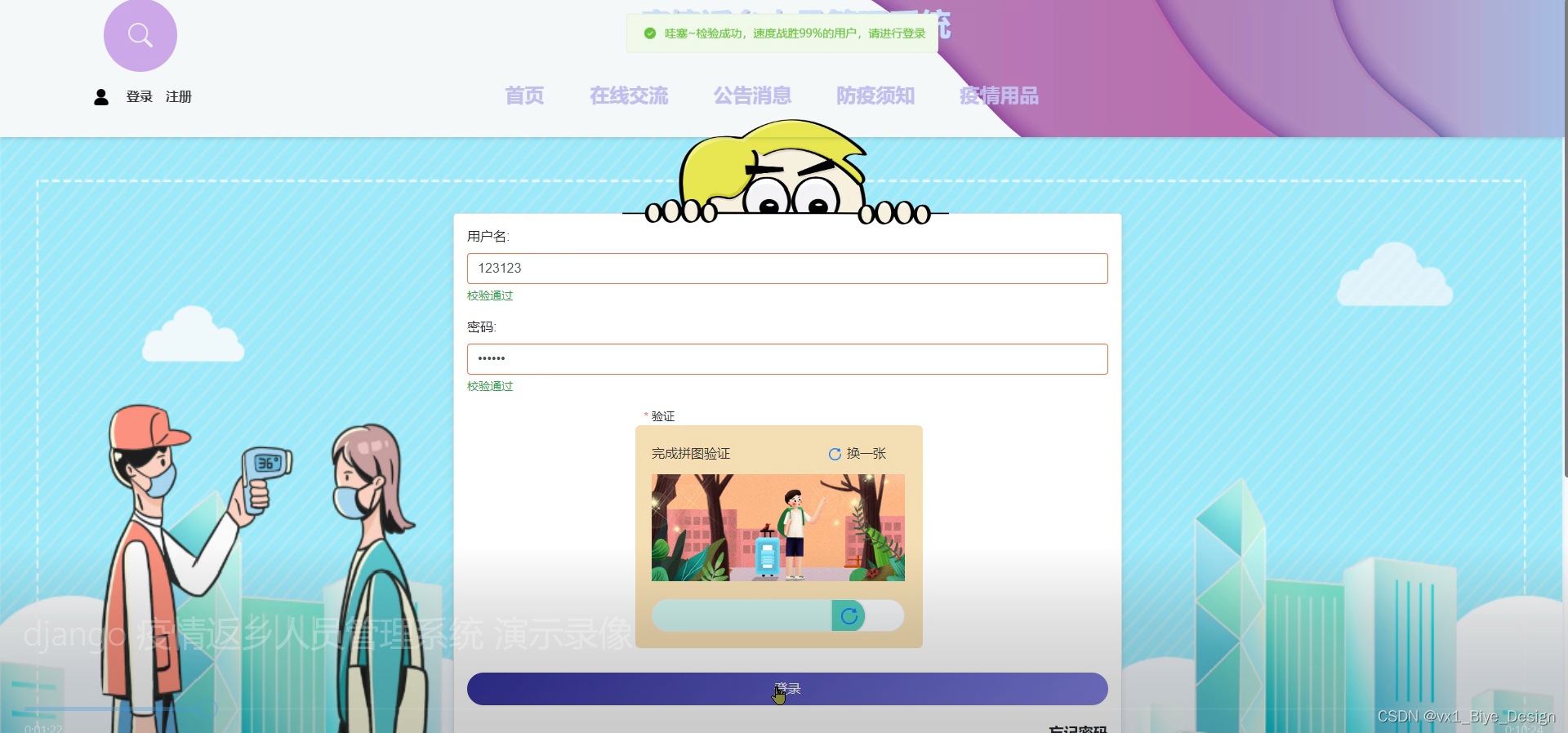
图5-1登录界面
用户界面要尽量简洁大方,使用户能够方便找到需要的功能入口,查看公告消息、在线交流、防疫须知、疫情用品等,且要易于修改和维护,同时还要保证用户合法和系统安全。
首页界面如下图所示。

图5-2首页界面
用户进入系统首页后,点击“注册”链接进入到注册页面,按照页面提示输入用户名密码和手机号,页面进行表单验证,验证输入的用户名和账号是否合法,表单验证通过后,点击“立即注册”按钮,利用 Ajax 技术,对用户名和账号实现页面无刷新验证,检测数据库中是否已经存在该用户名,若数据库中不存在,则注册成功,注册成功后,自动跳转到登录页面。
注册界面如下图所示。

图5-3注册界面
防疫须知页面,用户可以浏览防疫须知内容包括:标题、内容、发布时间等。如下图所示。
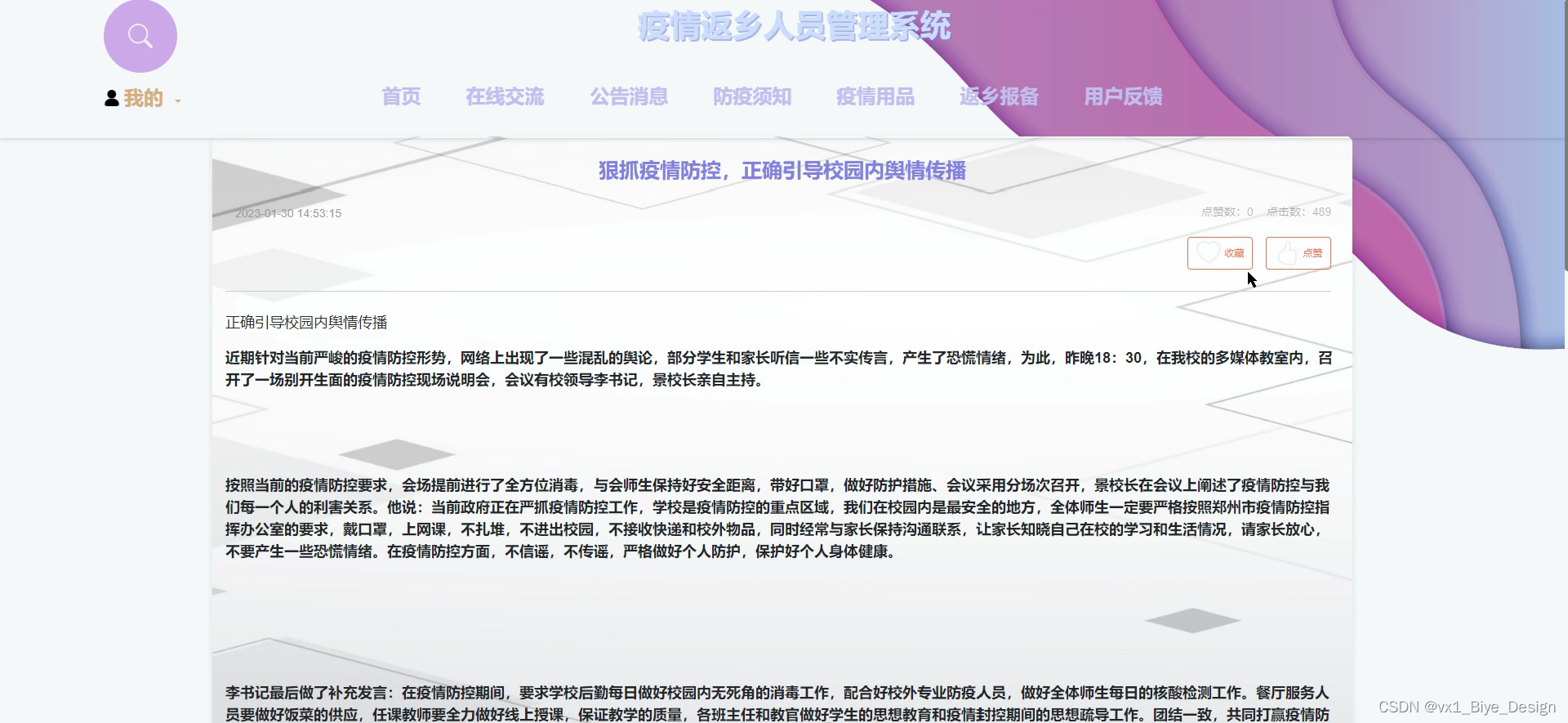
图5-4防疫须知页面
系统首页提供了疫情用品的搜索框,用户在搜索框内输入具体的疫情用品名称,点击搜索按钮,系统将用户搜索的疫情用品传递到后台。首先创建一个实体类 PageBean,该实体类的属性包括页码 pageCode、每页记录数 pageSize、总记录数 totalRecord 和一个 List 集合 beanList,用循环将搜索到的结果分页展示。
疫情用品界面如下图所示。

图5-5疫情用品界面
返乡报备需要用户在线进行提交,主要点击“返乡报备”界面进行个人报备信息填写,包括:返前地址、返后地址、隔离酒店、酒店地址、核酸信息、隔离开始、隔离结束、健康码、报备日期等信息,完善信息后进行报备提交。界面如下图所示。
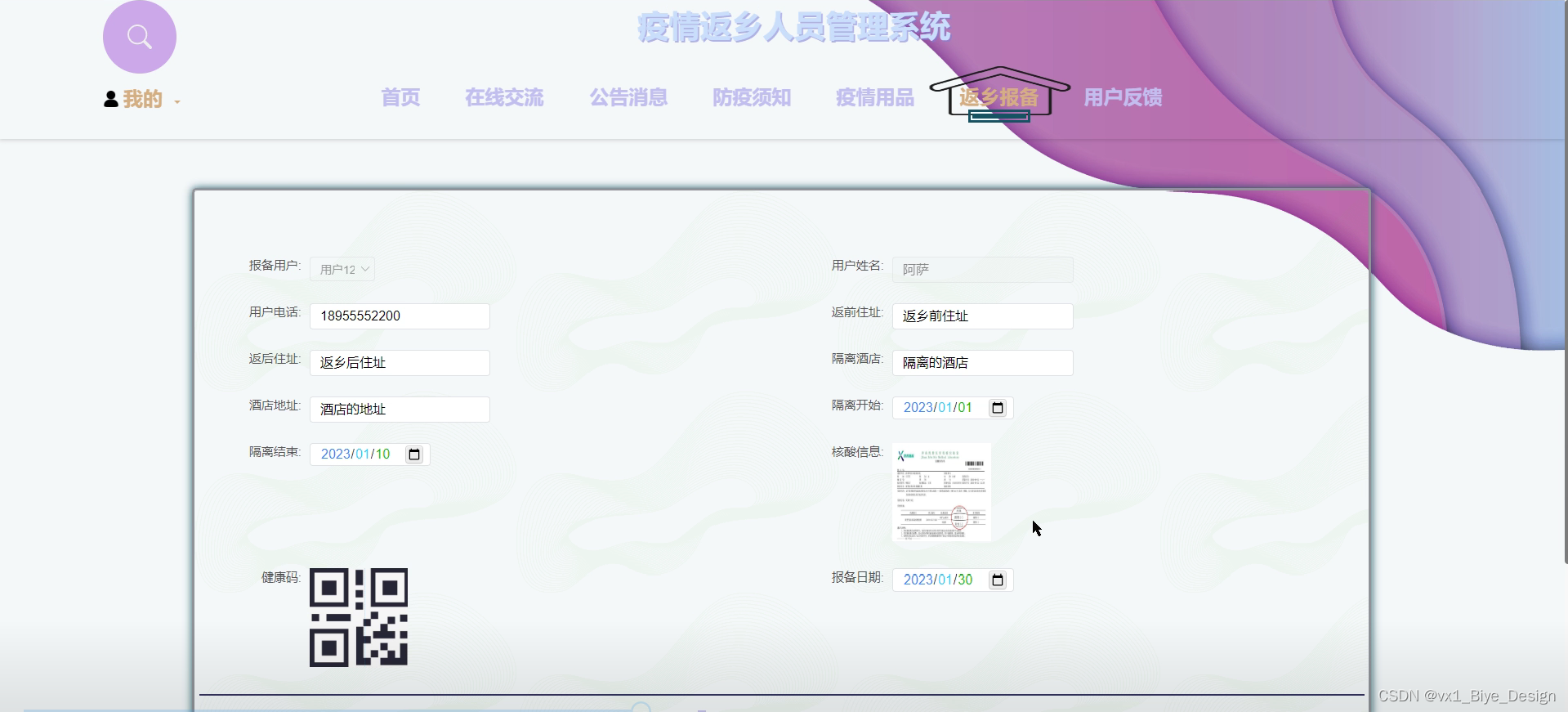
图5-6返乡报备界面
管理员对系统用户的管理,在管理员管理实现管理员用户的管理,包括录入、删除、修改,修改密码通过SESSION获取用户名,然后输入新密码,使用sql命令更新密码。
用户管理界面如下图所示。
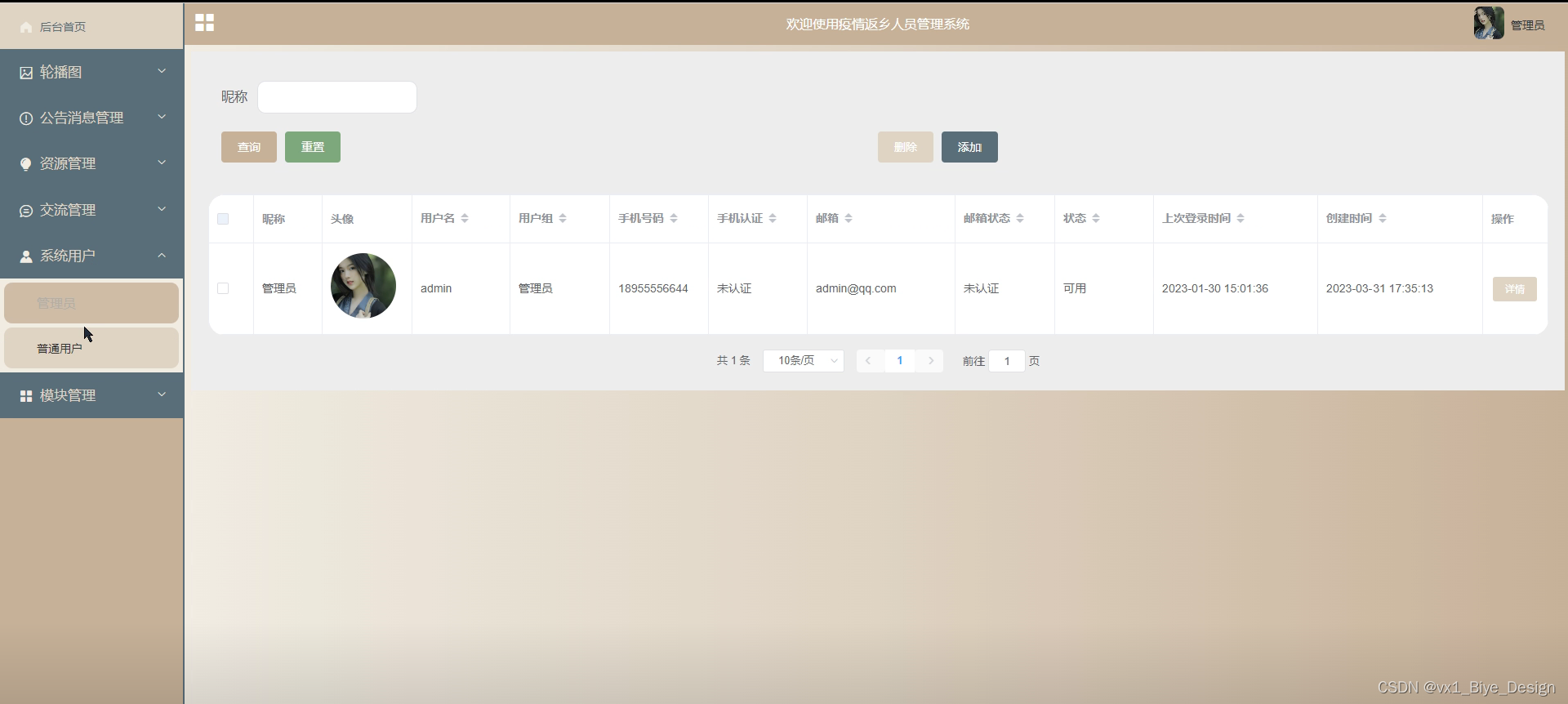
图5-7用户管理界面
管理员可以获取系统中所有疫情用品信息列表,并可以对其信息进行编辑。管理员需要输入新增、修改、删除、查询等,并对其进行维护管理等。
疫情用品管理界面如下图所示。

图5-8疫情用品管理界面
管理员可以对用户反馈信息进行维护管理,具体界面如下图所示。
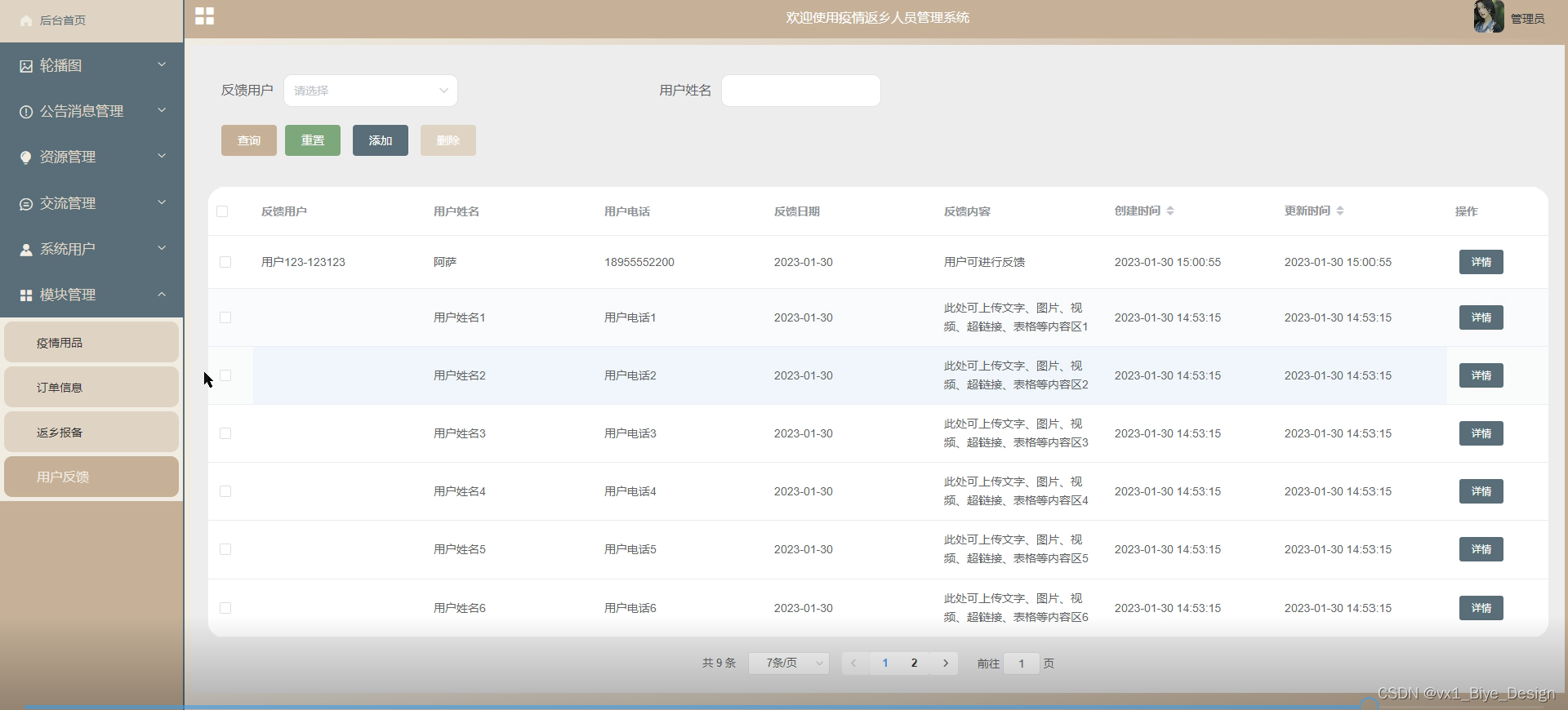
图5-9用户反馈管理界面
以进入系统首页的访问速度为例展示系统的性能测试;系统的主要用户群体是购物理念较为先进的消费者,系统要在3秒钟内响应;需要完成页面的菜单栏、首页轮播图片、公告信息、翻译须知、疫情用品、返乡报备以及各功能模块入口等元素的显示。
功能性测试是指执行指定的工作流程,通过对一个系统的所有特性和功能都进行测试确保符合需求和规范。
系统功能性测试表如下表所示。
表11系统功能性测试表
| 编号 |
测试功能 |
测试内容 |
测试结果 |
| 1 |
用户登录 |
1.验证用户名与密码的正确性。 2.验证密码是否可见。 |
通过 |
| 2 |
首页展示 |
1.首页数据是否成功加载。 2.验证搜索功能的准确性。 3.验证是否可以异步加载。 4.验证导航栏按钮。 |
通过 |
| 3 |
个人信息修改 |
1.验证登录名是否可以正常更改。 2.验证联系方式是否可以更改。 3.验证密码是否可以修改。 |
通过 |
| 4 |
疫情用品管理 |
1.疫情用品列表是否可以生成。 2.验证信息是否准确。 |
通过 |
| 7 |
防疫须知管理 |
1.验证防疫须知新增是否可以成功。 2.验证防疫须知删除是否可以成功。 |
通过 |
| 8 |
订单信息管理 |
1.订单信息是否与上传一致。 2.新增、删除、修改。 |
通过 |
| 9 |
用户管理 |
1.验证用户录入功能。 2.验证用户违规清理功能。 |
通过 |
集成测试后,所有的模块已经全部连接完毕,形成了一个完整的系统。合格性测试是在集成测试完毕后,进一步对系统进行综合性的检测。经过合格性测试,可以检查出系统是否符合系统的设计,能够完成需求的所有功能。本系统经过最后的测试,所有模块功能都能按预定要求工作。
在实际测试中,经过一系列系统性的测试,使我们能够及时发现一些系统在设计中出现的疏忽和漏洞。经过严密的测试,不仅发现了模块内部的错误,也查找到模块连接后产生的错误。经过测试,对系统产生错误的地方进行优化、修改和完善,使得系统能够实现最初设计的基本功能。
本文针对疫情返乡人员管理系统的特点和用户需求,利用 Python相关技术、Django框架和等技术,通过详细的需求分析、页面设计和功能设计,系统利用JQuery 技术和 CSS 技术进行了页面设计,实现了包括用户模块、防疫须知模块、疫情用品模块、返乡报备模块的前台系统以及包括用户管理模块、用户反馈管理模块、防疫须知管理模块的后台系统。并添加了用户的访问控制,建立了一个完整、健壮、安全稳定的疫情返乡人员管理系统。
由于时间限制和本人能力条件有限,还存在一些不足,今后也会出现许多新的开发技术,未来还可以对程序做出如下改进:
(1)优化程序页面,使页面更加美观且方便操作;
(2)优化信息搜索功能,提供多条件选择查询搜索;
(3)进一步提高使用程序的安全性,使其更加健壮;
(4)优化数据和代码,提升软件效率,方便维护和扩展。
参考文献
[1]郑均雷.新冠肺炎疫情背景下防控工作能力提升研究[J].林区教学,2022(01):1-4.
[2]舒爱平,杨植.新时期参与疫情防控的长效机制与路径研究[J].产业与科技论坛,2022,21(02):221-222.
[3]滕达,李雪.新冠病毒疫情期间的防控策略探索[J].产业与科技论坛,2022,21(02):255-256.
[4]全面筑牢边境疫情防控铜墙铁壁[J].云南农业,2022(01):95.
[5]鄢姿.常态化疫情防控下的网络舆情应对探赜[J].闽南师范大学学报(哲学社会科学版),2021,35(04):122-126.
[6]莫岚远. 打造“校园模式” 筑牢防控屏障[N]. 南宁日报,2021-12-20(001).
[7]薛仰全. 构建科学有效防控机制 全力保障社会安全稳定[N]. 甘肃日报,2021-12-08(010).
[8]陈骏君,郭强,赖清楠,赵英. 基于领域驱动设计的疫情防控系统[C]//中国计算机用户协会网络应用分会2021年第二十五届网络新技术与应用年会论文集.,2021:142-146.
[9]胡若彤,黄柯毓,胡荣,徐雨清,马秀萍,程林.标准化视角下的疫情防控体系构建及评价研究[J].大众标准化,2021(21):230-233.
[10]刘利,秦晓明,代红英,卢晓红,张光贵.我国新冠肺炎疫情应急反应能力分析——基于网站对疫情防控信息的报道[J].卫生职业教育,2021,39(20):157-159.
[11]邱敏,梁婷婷,梁天友.基于Echarts数据分析的疫情防控系统设计[J].物联网技术,2021,11(10):100-102.
[12]李志鸿,李金忠,肖延龙,钟鸣山,周先亮,邹聪波.疫情防控平台的设计与实现[J].井冈山大学学报(自然科学版),2021,42(05):70-77.
[13]高艳芹.新冠肺炎疫情防控常态化背景下高校安全保卫措施研究[J].现代职业安全,2021(06):71-73.
[14]胡琨. 基于微服务的疫情防控系统的设计与实现[D].武汉轻工大学,2021.
[15]余秋兰.智能测温系统应用场景的研究[J].电脑知识与技术,2021,17(16):193-194.
[16]王黎玮,颜晔,胡金星,王雨馨.疫情防控常态化下大数据在安全管理中的应用研究[J].黑龙江人力资源和社会保障,2021(07):27-31.
[17]Lipeng Gao,Wei Zheng,Hongping Gan,Depeng Gao,Xikang Feng.Research and Practice of Hybrid Teaching for Software Testing based on Interactive Learning[J].计算机教育,2021(12):126-131.
致谢
时光飞逝,转眼间我在学校的这些年生活即将结束,回顾这几年的学习生活,收获良多,既有幸福也有难过,学校生活的结束对于我来说也是一个新的开始。论文即将完成,在此,我心中有许多想要感谢的人。首先感谢我的导师,不仅在学习研究方面加以指导,也在生活和为人处世上给予帮助。还要感谢授课老师,你们严谨的学术精神和积极向上的工作态度都在激励我的成长和进步。感谢多年来一直生活在一起的室友,谢谢你们多年来的陪伴和照顾。最后,要感谢各位论文评审老师,感谢您们在百忙之中抽空评阅本论文并给出宝贵的意见和建议。
免费领取项目源码,请关注❥点赞收藏并私信博主,谢谢~